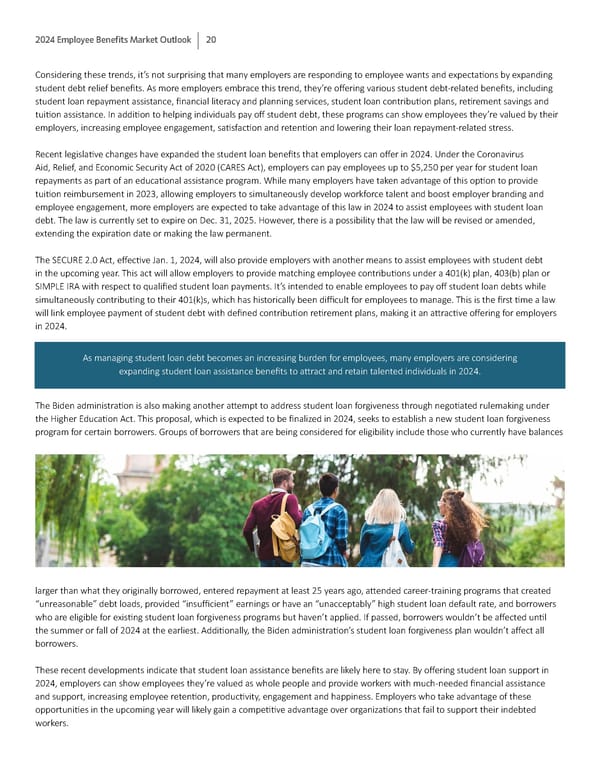2024 Employee Benefits Market Outlook 20 Considering these trends, it’s not surprising that many employers are responding to employee wants and expecta琀椀ons by expanding student debt relief bene昀椀ts. As more employers embrace this trend, they’re o昀昀ering various student debt-related bene昀椀ts, including student loan repayment assistance, 昀椀nancial literacy and planning services, student loan contribu琀椀on plans, re琀椀rement savings and tui琀椀on assistance. In addi琀椀on to helping individuals pay o昀昀 student debt, these programs can show employees they’re valued by their employers, increasing employee engagement, sa琀椀sfac琀椀on and reten琀椀on and lowering their loan repayment-related stress. Recent legisla琀椀ve changes have expanded the student loan bene昀椀ts that employers can o昀昀er in 2024. Under the Coronavirus Aid, Relief, and Economic Security Act of 2020 (CARES Act), employers can pay employees up to $5,250 per year for student loan repayments as part of an educa琀椀onal assistance program. While many employers have taken advantage of this op琀椀on to provide tui琀椀on reimbursement in 2023, allowing employers to simultaneously develop workforce talent and boost employer branding and employee engagement, more employers are expected to take advantage of this law in 2024 to assist employees with student loan debt. The law is currently set to expire on Dec. 31, 2025. However, there is a possibility that the law will be revised or amended, extending the expira琀椀on date or making the law permanent. The SECURE 2.0 Act, e昀昀ec琀椀ve Jan. 1, 2024, will also provide employers with another means to assist employees with student debt in the upcoming year. This act will allow employers to provide matching employee contribu琀椀ons under a 401(k) plan, 403(b) plan or SIMPLE IRA with respect to quali昀椀ed student loan payments. It’s intended to enable employees to pay o昀昀 student loan debts while simultaneously contribu琀椀ng to their 401(k)s, which has historically been di昀케cult for employees to manage. This is the 昀椀rst 琀椀me a law will link employee payment of student debt with de昀椀ned contribu琀椀on re琀椀rement plans, making it an a琀琀rac琀椀ve o昀昀ering for employers in 2024. As managing student loan debt becomes an increasing burden for employees, many employers are considering expanding student loan assistance bene昀椀ts to a琀琀ract and retain talented individuals in 2024. The Biden administra琀椀on is also making another a琀琀empt to address student loan forgiveness through nego琀椀ated rulemaking under the Higher Educa琀椀on Act. This proposal, which is expected to be 昀椀nalized in 2024, seeks to establish a new student loan forgiveness program for certain borrowers. Groups of borrowers that are being considered for eligibility include those who currently have balances larger than what they originally borrowed, entered repayment at least 25 years ago, a琀琀ended career-training programs that created “unreasonable” debt loads, provided “insu昀케cient” earnings or have an “unacceptably” high student loan default rate, and borrowers who are eligible for exis琀椀ng student loan forgiveness programs but haven’t applied. If passed, borrowers wouldn’t be a昀昀ected un琀椀l the summer or fall of 2024 at the earliest. Addi琀椀onally, the Biden administra琀椀on’s student loan forgiveness plan wouldn’t a昀昀ect all borrowers. These recent developments indicate that student loan assistance bene昀椀ts are likely here to stay. By o昀昀ering student loan support in 2024, employers can show employees they’re valued as whole people and provide workers with much-needed 昀椀nancial assistance and support, increasing employee reten琀椀on, produc琀椀vity, engagement and happiness. Employers who take advantage of these opportuni琀椀es in the upcoming year will likely gain a compe琀椀琀椀ve advantage over organiza琀椀ons that fail to support their indebted workers.
 2024 Employee Benefits Market Outlook Page 19 Page 21
2024 Employee Benefits Market Outlook Page 19 Page 21